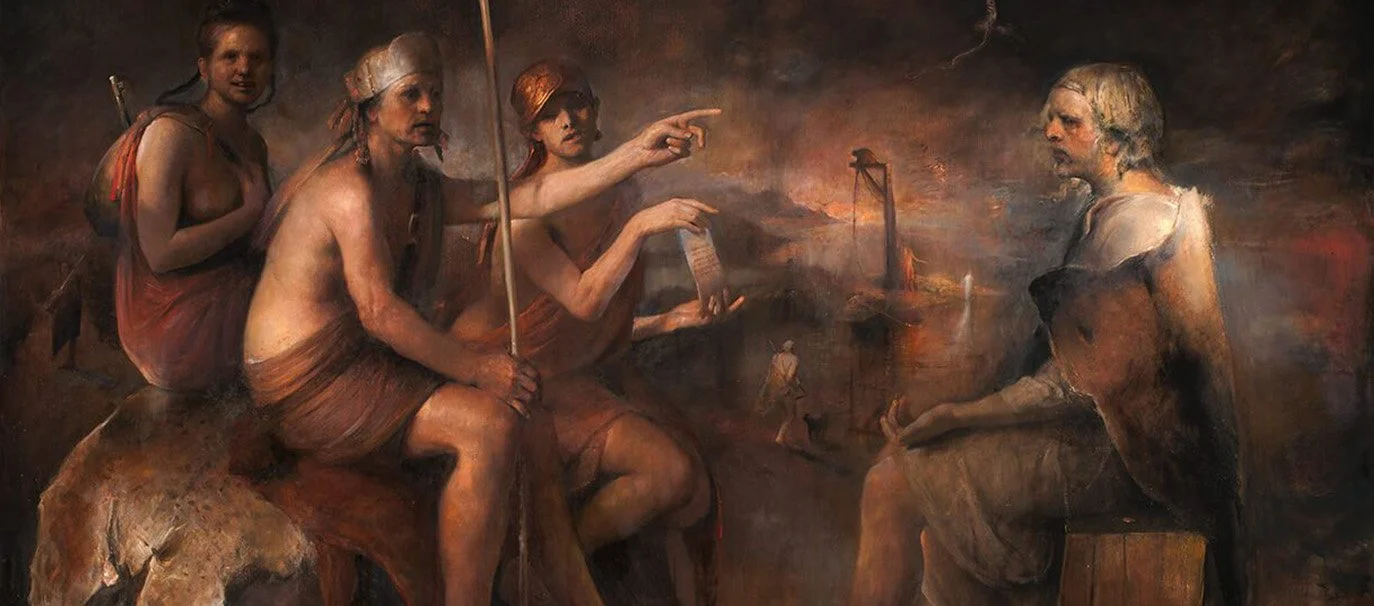The Importance of Being Odd: Nerdrum's Challenge to Modernism
The Norwegian artist Odd Nerdrum is one of the greatest painters of the century. Unfortunately, according to his detractors, the century in question is the seventeenth. Thus Nerdrum has emerged as one of the most controversial artists of our day. His admirers praise him for his superb Old Master technique, while his critics condemn him as hopelessly reactionary. His work calls into question all our customary narratives about art history, and especially the modernist dogma that the artist can be creative only by turning his back on the past.
Nerdrum has openly acknowledged his debt to the Old Masters. He uses heavy layers of paint to create chiaroscuro effects reminiscent of Caravaggio and Rembrandt, and he also continually recalls the achievement of the great Italian and Dutch painters in his ability to capture the texture of things on canvas -- from shiny metals to rich fabrics. Above all, he knows how to convey every shade of human flesh. And yet the subject matter of Nerdrum's works is usually enough to place him in the modern world. His dark palette seems to underwrite a disturbing vision of the end of civilization as we know it. For those who have not seen Nerdrum's paintings, I try to describe them this way: imagine the result if Rembrandt had painted the sets of The Road Warrior.
Nerdrum's career thus presents a challenge to the modernist establishment that still dominates the international art scene. He refuses to paint like a modernist, but thematically he seems to be responding to a crisis in the modern world; indeed he seems to be coming to grips with the spiritual state of modernity in a way far more profound than that pursued by most modernist painters. As a result, few contemporary painters have managed to enrage the modernist establishment as much as Nerdrum has. The artists, critics, and curators who comprise the modernist establishment somehow sense that if Nerdrum is right, then they must be wrong. By returning to the Old Masters, Nerdrum is violating what has come to be the fundamental convention of modernist art. Thumbing his nose at the whole art establishment, Nerdrum used the occasion of a series of exhibitions of his paintings from 1998 to 2000 in Norway to proclaim himself publicly the King of Kitsch.
Nerdrum's career as an artist has been one long struggle against modernism. Like many artists, Nerdrum was precocious and began to demonstrate an eye for form and color at an early age. Thus Nerdrum's encounter with and struggle against modernism began in his childhood, as he explains in his book On Kitsch:
I was captured by art at an early age, and painted Poliakoff-like abstractions before I turned 9. A reason for this was probably my stepfather. He was a cultivated man who collected modern art. Often he took me on skiing trips... Once, when we reached a height, we stopped and looked at the scenery. The valley in front of us lay bathing in the light from a magnificent sunset. Then he said: It is beautiful, but remember never to paint anything like this if you become an artist, then you will not be accepted at the Autumn Exhibition.
This anecdote of little Odd being browbeaten into becoming a modernist by a wicked stepfather is a marvelous inversion of the foundation myth of modern art: the young Picasso rebelling against his father who kept telling him that he must paint in a traditional style if he wanted to be a commercial success.
Temperamentally a rebel, Nerdrum quickly began to develop doubts about the artistic principles being forced upon him. In 1962, he entered the National Academy of Art in Oslo, but in such a way that to him the whole process seemed tainted. As one of his supporters, Jan Åke Pettersson, explains: "The application had included three paintings. Two of them were reasonably finished, while the third one had been hurriedly thrown together to meet the deadline. The fact that this was the one that the committee found so promising as to admit him into the nation's leading art school, made him question the criteria applied to modern art. This was too easy; it offered too little resistance." Already in his early teens, Nerdrum traveled all over Europe and eventually even to New York to broaden his knowledge of art.
He grew increasingly disillusioned with the work of modernists such as Robert Rauschenberg. As Nerdrum himself reports: "Modernism felt old and sad. I had seen so much of it that I was fed up." With such an attitude, it was not long before Nerdrum ran afoul of the Norwegian art authorities. In 1964 he took part in an exhibition in Oslo, revealing for the first time his old-master style and immediately provoking the hostility of the Norwegian art press. A critic named Ole Henrik Moe wrote in Afterposten: "It simply won't do to ignore a whole generation of progress towards the limits of abstraction, to deny surrealism, cubism, Klee, Kandinsky, Picasso, Francis Bacon... It takes courage, however, to face up to one's own time, more courage than is needed to beat the baby drum of reactionism." One might doubt the generosity of an art critic who beats a twenty-year old art student with the stick of Picasso, but the real question is whether Nerdrum was in fact exhibiting more courage by challenging what had become in his day the orthodoxy of modernism.
Nerdrum soon found that he could not get along with his professors at the Oslo Academy and eventually was "chased out like a mangy dog," as he put it. He never gave up trying to exhibit his works in his native country, but his efforts continued to meet with opposition. In 1998, he recalled with some bitterness the humiliation he had suffered some twenty years earlier: "I had been allowed to hang two of my larger paintings -- The Arrest and The Murder of Andreas Baader -- in the new students house at the University of Oslo... They were beautifully hung in a staircase, which almost looked like a Caravaggio chapel. But it did not take long before someone disliked the show. A committee at The Academy of Art had decided that the paintings in this particular staircase had to come down."
As recently as the 1990s, Nerdrum became embroiled in a bitter battle with the Norwegian art establishment. Nerdrum had long been publicly complaining that the Norwegian National Academy of Art did not offer classes in figurative painting, and in 1988 a group of his private students joined in the agitation. By 1994, Pettersson had become head of the Academy in Oslo, and tried to get two professorships in figurative technique established. As Pettersson himself describes the results: "All hell broke loose. Staff and students alike protested vociferously against the idea, internally as well as in the media." With his international reputation as a figurative painter, Nerdrum was clearly in line for one of the new professorships, and was indeed judged "in a class of his own" by the committee charged with evaluating his credentials. But as Pettersson reports, "the resistance at the Academy, as well as in parts of Norwegian society, now escalated into hysteria."
Even foreigners became involved in the dispute. The Norwegian minister of education, Gudmund Hernes, had used the occasion of a speech at the Academy to defend the idea of teaching figurative technique at a public art institution. The American artist Joseph Kosuth, who was in Oslo at the time, published a piece in which according to Pettersson "he argued against the minister and for banning this type of art from an academy, because it was 'popular' and not in line with the art of our century." Remember that what we are talking about here used to be a standard part of artistic instruction -- learning how to draw the human figure. And yet a Norwegian government official came under fire for advocating such a curricular reform. By the end of 1995, Nerdrum actually applied for the new teaching position, but the opposition to him was so strong that just one day before he would have been appointed, he chose to withdraw his name from consideration.
To give an idea of the violence of the opposition to Nerdrum, Pettersson describes how he was treated in the press: "Dagbladet, the tabloid that is Norway's third largest newspaper, printed an editorial that must be exceptional even in Norwegian cultural history... It concluded: 'Let it be said: Norwegian art ought to find room for many forms of expression, also Odd Nerdrum's. But we do not believe that he represents the future of Norwegian art, either at the Academy or anywhere else.'" Pettersson is obviously biased in favor of Nerdrum; one must therefore allow for the possibility that he may be narrating this story in a way as favorable to Nerdrum as possible. And yet one cannot help concluding that Nerdrum was done an injustice in the Academy affair.
Coming as it did at the end of the twentieth century, the Norwegian Academy affair provides a neat counterweight to the various modernist scandals at the beginning. In the early 1900s, Picasso began to shock the world by radically departing from traditional ways of representing the human figure, and he at first encountered fierce opposition from the art establishment. By the late 1990s, Nerdrum was faced with equally fierce opposition for championing traditional ways of drawing the human figure. One must wonder about the insecurity of modernists who feel it necessary to insist that their art and only their art is "the art of our century" or "the art of the future." Do the modernists fear the challenge traditional art still represents to the triumph of their own aesthetic? Under the circumstances, we are lucky to have heretics like Nerdrum to remind us of what modernism tries to exclude from the art world today. When asked to define "what is lacking in contemporary art," Nerdrum characteristically put together an odd but suggestive list of four things:
1. The open, trustful face,
2. The sensual skin,
3. Golden sunsets, and
4. The longing for eternity.
Fortunately, the rebellious child in Nerdrum continues his battle against his wicked stepfather and the modernist fear of beautiful sunsets.





